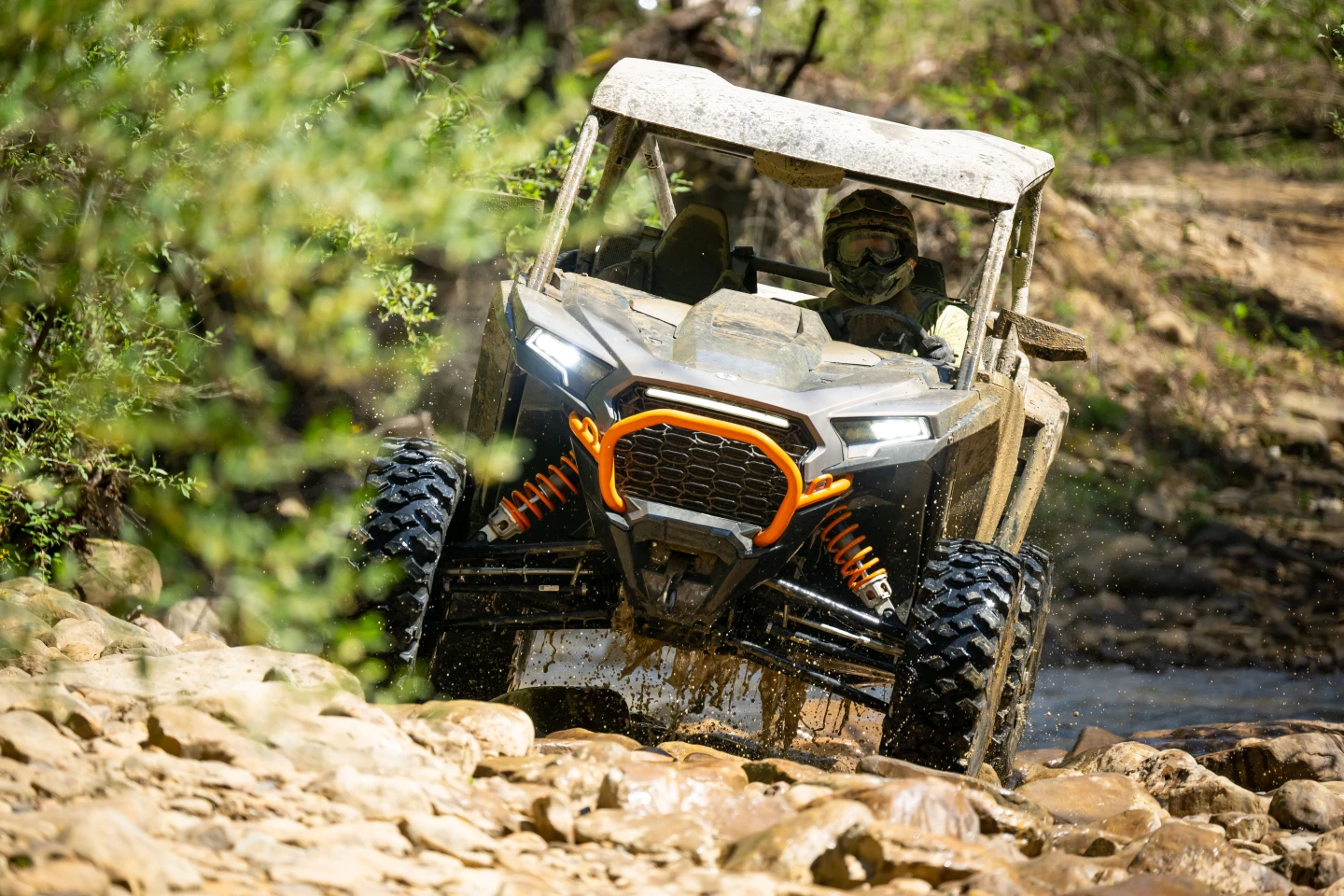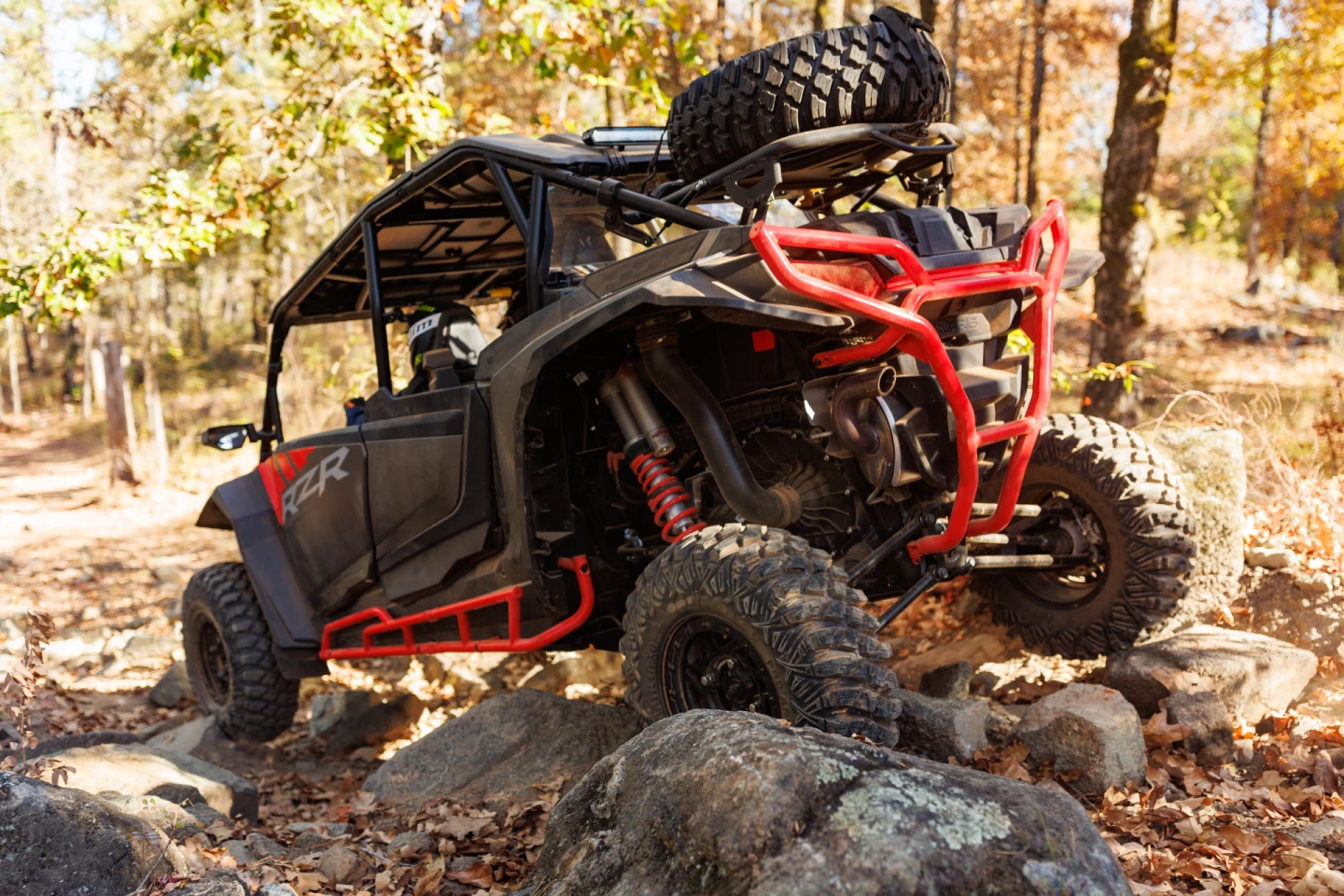Polaris has redesigned the RZR XP side-by-side. Designed for more rugged off-road use, the 2024 RZR XP 1000 sports a new chassis, engine and styling. We went to Tennessee during the state’s rainy season, and got mud all over ourselves and this new rig.
The RZR XP comes in two flavors: two-seat and four-seat. From there it’s all about accessories with quarter, half and full windscreens, storage racks, lighting options and other add-ons being part of the model lineup or upgrade options. We tried a few different setups during our day with these off-road machines, and learned how each affects the way the rig gets used.
Our first impression of the new RZR XP was that it’s awful pretty when fully equipped and shiny-clean on some gravel – clearly ready for its debut to eager journalists looking forward to a day of wilderness trails. Later on, we saw that it looks a lot better when covered in mud and dirt. We also learned that if you wanted water to curl up and into the cabin and land in your lap, get the quarter windscreen. If you wanted it to get all over you indiscriminately, go without a windscreen.
The author went through no fewer than a dozen rags wiping his goggles clear, and enjoyed every second of those splashdowns regardless.
Many of the changes on the 2024 RZR XP 1000 are fundamental. The chassis is 25% stronger, Polaris says, and is followed by a completely rethought driveline. Changes to half-shafts, the prop shaft, and bearings were done in order to add strength and reliability. The front bumper and its attached full-coverage ski plate were also rethought in order to better protect the area of most impact. Polaris retained Walker Evans Needle Shocks for the new RZR, but they’ve been re-tuned to provide better ride dynamics. These shocks have 16 positions of adjustment and 20.5 inches (52 cm) of travel.

These changes to the RZR XP are accompanied by a new engine, the ProStar 1000 Gen 2. This Polaris-built engine displaces 999 cc and outputs 114 horsepower (85 kW) to the transmission. That continuously variable transmission (CVT) is likely our only complaint for this rig, being a large source of intrusive noise for the machine. It handles the all-wheel drive system well, but whines loudly when being used to slow or curb speed in the downhills. Polaris has included a geared reverse, however, which makes pulling out of sticky situations a little easier.
The changes to the structure and mechanicals on the new RZR XP mean that it’s more rugged and capable than ever before. Tires up to 30 inches (76 cm) in size can be mounted from the factory, and ground clearance can go as high as 14.5 inches (37 cm).
Body styling changes for the RZR may not be obvious to most onlookers, but they consitute several improvements to the use of the rig, the plainest of those being sightlines and visual tracking. With or without a roof (that’s an option), the roll cage, door sills, and hood design all contribute to a much more driver-friendly platform for outward visibility. Compared to the RZR models we drove in Glamis, Arizona on the sand dunes, these XP models offer much more view area for the driver, whether looking forward or turning to glance over a shoulder. That improves not only safety, but also confidence and enjoyment.
The new doors are part of that change in design. They have a molded sealing surface between the front and rear doors on the four-door models, helping to keep most of the outside out and the inside in.
As with most off-road vehicle makers, Polaris knows that accessories are where the real attention goes for many buyers – and the company is offering a plethora of them for anyone interested. The rear storage area of the RZR XP is now accessible without tools and with a locking "trunk lid" option. Atop that, a rack for a spare tire or more gear can be added. That rack can open and close (with tire attached) with the cargo cover as needed. There is also a winch mount (made for the Pro HD 4,500 lb winch), fender flares, a stamped aluminum roof and more options.

Probably the most interesting options are new nesting cargo boxes and coolers, made to fit perfectly in the cargo area of the RZR XP 1000. A full roof and window kit is also available, with windshield wipers and a cabin heater option for a fully-enclosed drive.
Infotainment in the new RZR XP has most of Polaris’ available technologies included. The company’s patented trail system – which allows RZRs to connect and track one another without satellite connectivity, and offers downloadable or satellite-accessible mapping for most off-road areas in North America – are available. So is a Rockford Fosgate sound system with 100W speakers and a 400W subwoofer.
But electronics and added accessories aren’t the real reason people buy an off-road-focused side-by-side like this. It’s for the adventure. Which was why we’d traveled to Tennessee to start with.
That adventure included hours on the trails in the woods and muddy stretches of Windrock Park. With plenty of puddles, a couple of streams to ford, and a lot of beautiful scenery to behold, we took to that happily. The 2024 Polaris RZR XP 1000 took it all without fuss. We (accidentally) hit some rocks, playfully flew into large puddles, skidded across loose dirt, plowed through thick mud, and generally had a great time in the Tennessee trees. Sand, mud, water and occasional bugs caked our machines by the time we were finished. It was glorious.
The base price for the 2024 Polaris RZR XP 1000 is about US$21,000.
Product page: 2024 Polaris RZR XP 1000
























